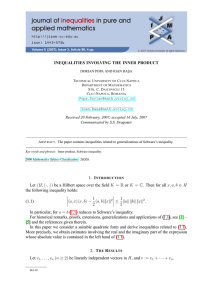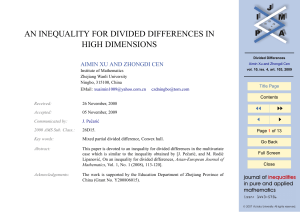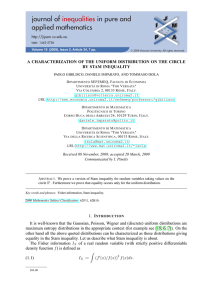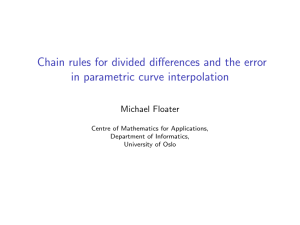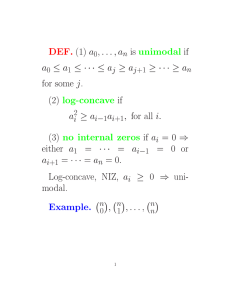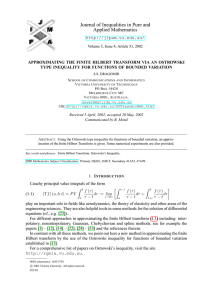AN INEQUALITY FOR DIVIDED DIFFERENCES IN HIGH DIMENSIONS
advertisement
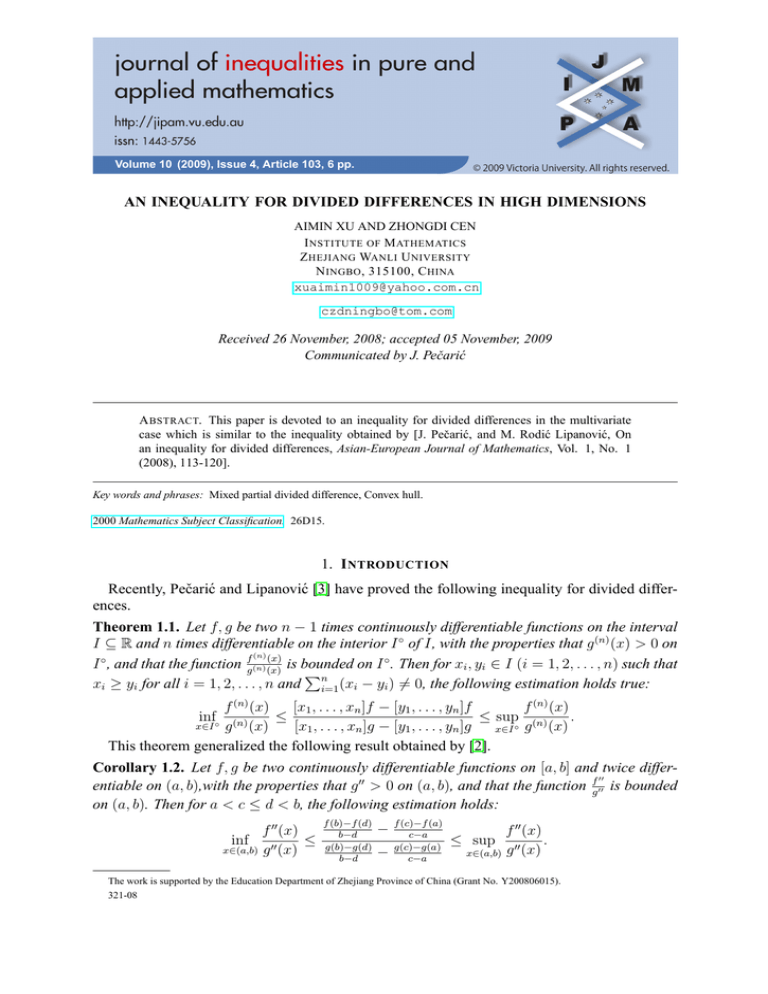
Volume 10 (2009), Issue 4, Article 103, 6 pp.
AN INEQUALITY FOR DIVIDED DIFFERENCES IN HIGH DIMENSIONS
AIMIN XU AND ZHONGDI CEN
I NSTITUTE OF M ATHEMATICS
Z HEJIANG WANLI U NIVERSITY
N INGBO , 315100, C HINA
xuaimin1009@yahoo.com.cn
czdningbo@tom.com
Received 26 November, 2008; accepted 05 November, 2009
Communicated by J. Pečarić
A BSTRACT. This paper is devoted to an inequality for divided differences in the multivariate
case which is similar to the inequality obtained by [J. Pečarić, and M. Rodić Lipanović, On
an inequality for divided differences, Asian-European Journal of Mathematics, Vol. 1, No. 1
(2008), 113-120].
Key words and phrases: Mixed partial divided difference, Convex hull.
2000 Mathematics Subject Classification. 26D15.
1. I NTRODUCTION
Recently, Pečarić and Lipanović [3] have proved the following inequality for divided differences.
Theorem 1.1. Let f, g be two n − 1 times continuously differentiable functions on the interval
I ⊆ R and n times differentiable on the interior I ◦ of I, with the properties that g (n) (x) > 0 on
(n) (x)
I ◦ , and that the function fg(n) (x)
is bounded on I ◦ . Then for xi , yi ∈ I (i = 1, 2, . . . , n) such that
P
xi ≥ yi for all i = 1, 2, . . . , n and ni=1 (xi − yi ) 6= 0, the following estimation holds true:
f (n) (x)
[x1 , . . . , xn ]f − [y1 , . . . , yn ]f
f (n) (x)
≤
≤
sup
.
(n) (x)
x∈I g (n) (x)
[x1 , . . . , xn ]g − [y1 , . . . , yn ]g
x∈I ◦ g
This theorem generalized the following result obtained by [2].
inf◦
Corollary 1.2. Let f, g be two continuously differentiable functions on [a, b] and twice differ00
entiable on (a, b),with the properties that g 00 > 0 on (a, b), and that the function fg00 is bounded
on (a, b). Then for a < c ≤ d < b, the following estimation holds:
f 00 (x)
≤
x∈(a,b) g 00 (x)
inf
f (b)−f (d)
b−d
g(b)−g(d)
b−d
−
−
f (c)−f (a)
c−a
g(c)−g(a)
c−a
f 00 (x)
.
00
x∈(a,b) g (x)
≤ sup
The work is supported by the Education Department of Zhejiang Province of China (Grant No. Y200806015).
321-08
2
A IMIN X U AND Z HONGDI C EN
It is worth noting that the technique of the proof for Theorem 1.1 in [3] is very natural
and useful. In this paper, using the technique and following the definition of mixed partial
divided difference proposed by [1], we present a similar inequality for divided differences in
the multivariate case.
2. N OTATIONS AND D EFINITIONS
The following notations will be used in this paper.
We denote by Rm the m−dimensional Euclidean space. Let x ∈ Rm be a vector denoted by
m
(x1 , x2 , . . . , xm ). Let N0 be the set of nonnegative integers. Then it is obvious that Nm
0 ⊆ R .
i
m
Denote by e ∈ N0 a unit vector whose jth component is δij , where
0,
j 6= i;
δij =
1,
j = i.
α1 α2
α
αm
Let 00 = 1. For α = (α1 , α2 , . . . , αm ) ∈ Nm
0Q, we define x = x1 x2 · · · xm , and then we
P
i
m
m
have xi = xe . Define |α| = m
i=1 αi , α! =
i=1 αi !. For x, y ∈ R , we denote x ≥ y, if
xi ≥ yi , i = 1, 2, . . . , m.
Further, let
α 1 α 2
α m
∂
∂
∂
α
···
D =
∂x1
∂x2
∂xm
be a mixed partial differential operator of order |α|.
For x0 , x1 , . . . , xn ∈ Rm , we denote by
(
!
)
n
n
X
X
0 1
x , x , . . . , xn =
1−
tj x0 + t1 x1 + · · · + tn xn | tj ≥ 0,
tj ≤ 1
j=1
0
1
n
j=1
m
the convex hull of x , x , . . . , x ∈ R . Then according to the Hermite-Genocchi formula
for univariate divided difference, the multivariate divided difference (or mixed partial divided
difference) of order n can be defined by the following formula.
0
1
n
m
Definition 2.1 ([1], see also [4, 5]). Let α ∈ Nm
0 with |α| = n, and x , x , . . . , x ∈ R . Then
the mixed partial divided difference of order n of f is defined by
!
!
Z
n
X
[x0 , x1 , . . . , xn ]α f =
Dα f
1−
tj x0 + t1 x1 + · · · + tn xn dt1 dt2 . . . dtn ,
Sn
where
j=1
(
n
S =
(t1 , t2 , . . . , tn )| tj ≥ 0, j = 1, 2, . . . , n;
n
X
)
tj ≤ 1 .
j=1
It is easy to see that if we let m = 1, then [x0 , x1 , . . . , xn ]α f is the ordinary divided difference
in the univariate case. By the definition of the mixed partial divided difference, we also conclude
that
[xσ0 , xσ1 , . . . , xσn ]α f = [x0 , x1 , . . . , xn ]α f
if (σ0 , σ1 , . . . , σn ) is a permutation of (0, 1, . . . , n). Finally, we give another definition to end
this section.
0
1
n
m
Definition 2.2 ([4, 5]). Let α ∈ Nm
0 with |α| = n, and x , x , . . . , x ∈ R . Then the Newton
fundamental functions are defined by
(
1,
n = 0,
P
Qn
j−1 eij
ωα (x, {xj }n−1
)
=
j=0
) ,
n > 0.
j=1 (x − x
ei1 +···+ein =α
J. Inequal. Pure and Appl. Math., 10(4) (2009), Art. 103, 6 pp.
http://jipam.vu.edu.au/
A N I NEQUALITY
FOR
D IVIDED D IFFERENCES IN H IGH D IMENSIONS
3
3. M AIN R ESULT
We start this section with two lemmas. Using the definition of the mixed partial divided
difference of f we have the following lemma.
n
0
1
n
Lemma 3.1 (cf. [4, 5]). Let α ∈ Nm
0 with |α| = n. If f ∈ C (hx , x , . . . , x i), then there
exists a point ξ ∈ hx0 , x1 , . . . , xn i such that
1
[x0 , x1 , . . . , xn ]α f = Dα f (ξ).
n!
Also using the definition, we have the recurrence relations of the divided differences.
Lemma 3.2. For β ∈ Nm
0 with |β| = n − 1, we have
1
2
n
0
1
[x , x , . . . , x ]β f − [x , x , . . . , x
n−1
]β f =
m
X
i
(xn − x0 )e [x0 , x1 , . . . , xn ]β+ei f.
i=1
Proof. By the chain rule for the derivative of the composite function, we have
!
!
n
X
∂ β
0
n
D f
1−
tj x + · · · + tn x
∂tn
j=1
!
!
m
n
X
X
i
i
=
Dβ+e f
1−
tj x0 + · · · + tn xn (xn − x0 )e .
i=1
Hence,
Z 1−Pn−1
m
j=1 tj X
0
D
β+ei
1−
f
n
X
i=1
j=1
!
tj
!
i
x0 + · · · + tn xn (xn − x0 )e dtn
j=1
= Dβ f
t1 x1 + · · · +
1−
n−1
X
!
!
tj
xn
j=1
− Dβ f
1−
n−1
X
!
tj
!
x0 + · · · + tn−1 xn−1
.
j=1
Thus,
Z X
m
D
β+ei
1−
f
S n i=1
n
X
!
!
i
x0 + · · · + tn xn (xn − x0 )e dtn . . . dt1
tj
j=1
Z
=
Dβ f
t1 x1 + · · · +
1−
S n−1
n−1
X
!
tj
!
xn dt1 . . . dtn−1
j=1
Z
−
Dβ f
S n−1
1−
n−1
X
!
tj
!
x0 + · · · + tn−1 xn−1
dt1 . . . dtn−1 ,
j=1
which implies
m
X
i
(xn − x0 )e [x0 , x1 , . . . , xn ]β+ei f = [x1 , x2 , . . . , xn ]β f − [x0 , x1 , . . . , xn−1 ]β f.
i=1
This completes the proof.
J. Inequal. Pure and Appl. Math., 10(4) (2009), Art. 103, 6 pp.
http://jipam.vu.edu.au/
4
A IMIN X U AND Z HONGDI C EN
Let hx0 , . . . , xn , y 0 , . . . , y n i be the convex hull of x0 , x1 , . . . , xn , y 0 , y 1 , . . . , y n . Now, we
state our main theorem as follows.
Theorem 3.3. Let f, g ∈ C n+1 (hx0 , . . . , xn , y 0 , . . . , y n i), α ∈ Nm
0 , and |α| = n. If for all
0
n 0
n
α+ei
z ∈ hx , . . . , x , y , . . . , y i we have D
g(z) > 0 (i = 1, 2, . . . , m) and for all xj , y j
P
P
n
j
j ei
(j = 0, 1, . . . , n) we have xj ≥ y j and j=0 m
i=1 (x − y ) 6= 0, then
[x0 , x1 , . . . , xn ]α f − [y 0 , y 1 , . . . , y n ]α f
L≤ 0 1
≤ U,
[x , x , . . . , xn ]α g − [y 0 , y 1 , . . . , y n ]α g
where
i
Dα+e f (z)
L = min
inf
,
i
1≤i≤m z∈hx0 ,...,xn ,y 0 ,...,y n i D α+e g(z)
i
Dα+e f (z)
.
i
1≤i≤m z∈hx0 ,...,xn ,y 0 ,...,y n i D α+e g(z)
U = max
sup
Proof. It is evident that
i
Dα+e f (z)
L≤
inf
i
z∈hx0 ,...,xn ,y 0 ,...,y n i D α+e g(z)
i
≤
i
Dα+e f (z)
Dα+e f (z)
≤
sup
≤ U.
Dα+ei g(z) z∈hx0 ,...,xn ,y0 ,...,yn i Dα+ei g(z)
i
Since Dα+e g(z) > 0, 1 ≤ i ≤ m, then
i
i
i
LDα+e g(z) ≤ Dα+e f (z) ≤ U Dα+e g(z).
(3.1)
Let
x̄ =
1−
n
X
!
x0 + t1 x1 + · · · + tn xn ,
tj
j=1
ȳ =
1−
n
X
!
tj
y 0 + t1 y 1 + · · · + tn y n .
j=1
i
i
Since f, g ∈ C n+1 (hx0 , . . . , xn , y 0 , . . . , y n i), Dα+e g(z) and Dα+e f (z) are continuous on each
of the contours between the points ȳ and x̄. Then we can find three line integrals satisfying
Z x̄ X
Z x̄ X
Z x̄ X
m
m
m
i
α+ei
α+ei
L
D
g(z)dzi ≤
D
f (z)dzi ≤ U
Dα+e g(z)dzi .
ȳ
i=1
ȳ
i=1
ȳ
i=1
This implies that
(3.2)
L[Dα g(x̄) − Dα g(ȳ)] ≤ Dα f (x̄) − Dα f (ȳ) ≤ U [Dα g(x̄) − Dα g(ȳ)].
Integrating (3.2) with respect to t1 , t2 , . . . , tn over the n-dimensional simplex Sn as defined in
the previous section, we arrive at
L([x0 , x1 , . . . ,xn ]α g − [y 0 , y 1 , . . . , y n ]α g)
≤ [x0 , x1 , . . . , xn ]α f − [y 0 , y 1 , . . . , y n ]α f
≤ U ([x0 , x1 , . . . , xn ]α g − [y 0 , y 1 , . . . , y n ]α g).
J. Inequal. Pure and Appl. Math., 10(4) (2009), Art. 103, 6 pp.
http://jipam.vu.edu.au/
A N I NEQUALITY
D IVIDED D IFFERENCES IN H IGH D IMENSIONS
FOR
5
Using Lemmas 3.1 and 3.2, we have
0
1
0
n
1
n X
m
X
n
[x , x , . . . , x ]α g − [y , y , . . . , y ]α g =
i
(xj − y j )e [y 0 , . . . , y j , xj , . . . , xn ]α+ei g
j=0 i=1
n
m
XX
1
i
i
(xj − y j )e Dα+e g(ξi,j ),
=
(n + 1)! j=0 i=1
P P
j
j ei
α+ei
where ξi,j ∈ hx0 , . . . , xn , y 0 , . . . , y n i. Since xj ≥ y j , nj=0 m
g(z) >
i=1 (x −y ) 6= 0 and D
0, we have
[x0 , x1 , . . . , xn ]α g − [y 0 , y 1 , . . . , y n ]α g > 0.
Thus,
L≤
[x0 , x1 , . . . , xn ]α f − [y 0 , y 1 , . . . , y n ]α f
≤ U.
[x0 , x1 , . . . , xn ]α g − [y 0 , y 1 , . . . , y n ]α g
This completes the proof.
P
i
Considering pi (z) = ei0 +ei1 +···+ein =α+ei z α+e , i = 1, 2, . . . , m, we can obtain that
pi (z) = ωα+ei (z, {0}nj=0 ).
Further, let
m
X
1
p(z) =
pi (z).
(n + 1)! i=1
By calculating, we have
p(z) =
m
X
i=1
1
i
z α+e .
i
(α + e )!
This implies that, for 1 ≤ i ≤ m,
i
Dα+e p(z) = 1 > 0,
and
Dα p(z) =
m
X
i
ze .
i=1
Then
[x0 , x1 , . . . , xn ]α p =
Z
Dα p
1−
Sn
=
=
1−
Sn
tj
!
x0 + t1 x1 + · · · + tn xn dt1 dt2 · · · dtn
n
X
!ei
!
x0 + t1 x1 + · · · + tn xn
tj
dt1 dt2 · · · dtn
j=1
m Z
X
i=1
!
j=1
m Z
X
i=1
n
X
1−
Sn
n
X
!
!
tj
ei
ei
ei
(x0 ) + t1 (x1 ) + · · · + tn (xn )
dt1 dt2 · · · dtn
j=1
n
m
XX
1
i
=
(xj )e .
(n + 1)! j=0 i=1
Therefore, if we take g(z) = p(z) in Theorem 3.3, we have the following corollary.
J. Inequal. Pure and Appl. Math., 10(4) (2009), Art. 103, 6 pp.
http://jipam.vu.edu.au/
6
A IMIN X U AND Z HONGDI C EN
Corollary 3.4. Let f ∈ C n+1 (hx0 , . . . , xn , y 0 , . . . , y n i), α ∈ Nm
0 , and |α| = n. If for all
Pn Pm j
j
j
j
j
j ei
x , y (j = 0, 1, . . . , n) we have x ≥ y and j=0 i=1 (x − y ) 6= 0, then
L0 ≤ [x0 , x1 , . . . , xn ]α f − [y 0 , y 1 , . . . , y n ]α f ≤ U 0 ,
where
L0 =
n X
m
X
1
α+ei
j
j ei
min
inf
D
f
(z)
(x
−
y
) ,
(n + 1)! 1≤i≤m z∈hx0 ,...,xn ,y0 ,...,yn i
j=0 i=1
U0 =
n X
m
X
1
i
i
max
sup
Dα+e f (z)
(xj − y j )e .
(n + 1)! 1≤i≤m z∈hx0 ,...,xn ,y0 ,...,yn i
j=0 i=1
In fact, from the procedure of the proof of Theorem 3.3, it is not P
difficult
that the
P to find
j
j ei
conditions of the corollary can be weakened. If we replace xj ≥ y j and nj=0 m
(x
−y
) 6=
i=1
Pn Pm j
j ei
0 by j=0 i=1 (x − y ) > 0, the corollary holds true as well.
R EFERENCES
[1] A. CAVARETTA, C. MICCHELLI AND A. SHARMA, Multivariate interpolation and the Radon
transform, Math. Z., 174A (1980), 263–279.
[2] A.I. KECHRINIOTIS AND N.D. ASSIMAKIS, On the inequality of the difference of two integral
means and applications for pdfs, J. Inequal. Pure and Appl. Math., 8(1) (2007), Art. 10. [ONLINE:
http://jipam.vu.edu.au/article.php?sid=839].
[3] J. PEČARIĆ, AND M. RODIĆ LIPANOVIĆ, On an inequality for divided differences, AsianEuropean J. Math., 1(1) (2008), 113–120.
[4] X. WANG AND M. LAI, On multivariate newtonian interpolation, Scientia Sinica, 29 (1986), 23–32.
[5] X. WANG AND A. XU, On the divided difference form of Faà di Bruno formula II, J. Comput.
Math., 25(6) (2007), 697–704.
J. Inequal. Pure and Appl. Math., 10(4) (2009), Art. 103, 6 pp.
http://jipam.vu.edu.au/
